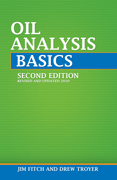Oil Analysis Basics - Second Edition
|
|
Bonus Pack Included
with this item. |
- Vendor: Noria Corporation
- Type: Book
Description
Oil Analysis Basics presents the fundamentals of oil analysis for machinery condition monitoring in an easy to understand format. You will learn everything from how to take a proper oil sample to how to select a test slate for your applications. With more than 90 illustrations, figures and lookup tables, you'll reference Oil Analysis Basics for years to come.
Plus You'll Find:
- Common elemental concentration ranges for different types of machines
- Contaminants and conditions that alter an oil's flash point
- Commonly used primary and secondary (confirming) oil analysis indicators
- Filter selection decision tree
- Common elements and their sources
- How to select the best sampling locations for oil analysis
- Factors to consider when designing an oil analysis program
- How to take oil samples to maximize data density and minimize data disturbance
- Diagnostic flow charts for:
- Particle count
- Viscosity
- Acid number
- Base number
- Ferrous density
- RPVOT
- Water contamination
- Elemental wear metals
- Glycol contamination
- Additive depletion
What’s New in the Second Edition?
- More detailed information on oil sampling
- 14 oil analysis tests were added
- New and expanded sections on filtration and contaminant removal
- Expanded discussion on base oils and additives
- New information on excluding contaminants from lubricants
- Expanded water-in-oil contamination and removal content
- Updated sections on new ASTM standards on in-service lube testing
- Expanded discussion on the importance of glycol testing
- Expanded discussion of flash point tests
- All chapters revised and updated
Author:
Jim Fitch & Drew TroyerPublished:
Noria CorporationFormat:
PaperbackPages:
192Excerpt:
1. How particles affect the oil - Particles, especially catalytic metal particles like copper, iron and lead increase the rate at which oxidation occurs. Particles also strip the oil of its polar additives, including anti-wear additives, extreme pressure additives, rust inhibitors and dispersants. Also, numerous very small particles in stable suspension can cause the oil's viscosity to increase.
How particles affect the machine - Abrasive particles are responsible for much of the wear leading to premature failure of mechanical components. Under sliding conditions, clearance-sized particles enter the oil film between surfaces and cut away material much like a lathe cuts metal. Under rolling contact conditions, particles transfer concentrated load between two surfaces in relative motion, resulting in surface fatigue, pitting, and spalling. Particle-contaminated oil traveling at high velocity can also cause erosive wear.
2. Rate-of-change alarms are typically set to measure properties that are being progressively introduced into the oil, such as wear debris. The add rate (change) can be calculated per unit of time, hours, cycles, etc. For example, a 100 ppm increase in iron over a period of 100 operating hours could be stated as one ppm per hour of operation. When the parameter is plotted against time, the rate-of-change (add rate) equals the current slope of the curve.
Unlike level limits, rate-of-change limits ignore the absolute value of the data parameter, emphasizing instead the speed at which the level is changing. Rate-of-change limits are effectively applied to particle counting (unfiltered systems), elemental wear metals, ferrous density, acid number (AN) and RPVOT. It can also be effectively applied to monitor abnormal degradation of additives with elemental and FTIR spectroscopy.
3. The amount of water that a given fluid will absorb depends upon its base stock, viscosity, additive package, and temperature. The amount of water that can dissolve in a fluid is termed its saturation level. The saturation level for a hydraulic fluid is 200-300 ppm while for a lubricating oil it is around 500-600 ppm. Oil is cloudy when it is above its saturation level. The saturation level for a synthetic fluid is generally much higher than for a mineral base fluid.
Table Of Contents:
-
Lubrication Fundamentals
- The Functions of a Lubricant
- Base Stock Considerations
- Lubrication Fundamentals
- Additives and their Functions
- Oil Analysis and Condition-Based Maintenance
- Reliability-Centered Maintenance (RCM)
-
Contamination Control
- Particle Contamination
- Moisture Contamination
- Fuel Contamination
- Soot Contamination
- Glycol Contamination
-
Oil Sampling Methods
- Sampling Locations on System Returns
- Live Zone Sampling from Circulating Systems
- Sampling from Pressurized Lines
- Sampling Wet-sump Circulating Systems
- Sampling Non-Circulating Systems
- Drop-Tube Vacuum Sampling
- Sampling Bottles and Hardware
- Important Tips for Effective Oil Sampling
- Oil Sampling Frequency
- Registering Equipment For Oil Analysis
- Sample Bottle Labels and Identification
-
Oil Testing and Analysis
- Reasons for Performing Oil Analysis
- Review of Common Used Oil Analysis Tests
- Selecting the Test Slate
-
Targets, Limits, Diagnostics and Data Management
- Setting Limits and Targets
- Interpreting and Applying Oil Analysis Results
- Documenting and Reporting Oil Analysis Results
- Integrating Oil Analysis with Other Condition Monitoring Techniques
-
Guidelines for Selecting and Working with a Commercial Oil Analysis Laboratory
- Appendix I - Glossary of Terms
- Abbreviations, Prefixes and Letter Symbols
- Prefixes - U.S. TERM
- Cleanliness Definitions




